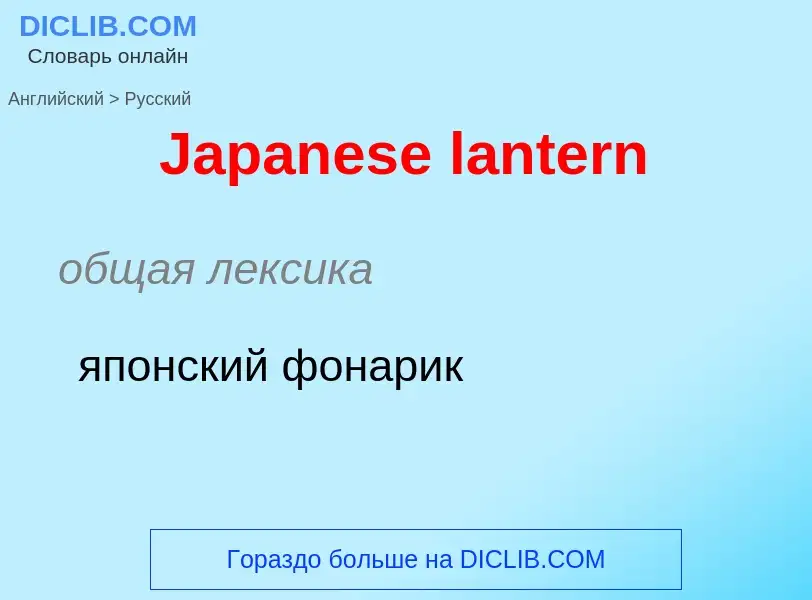Μετάφραση και ανάλυση λέξεων από την τεχνητή νοημοσύνη ChatGPT
Σε αυτήν τη σελίδα μπορείτε να λάβετε μια λεπτομερή ανάλυση μιας λέξης ή μιας φράσης, η οποία δημιουργήθηκε χρησιμοποιώντας το ChatGPT, την καλύτερη τεχνολογία τεχνητής νοημοσύνης μέχρι σήμερα:
- πώς χρησιμοποιείται η λέξη
- συχνότητα χρήσης
- χρησιμοποιείται πιο συχνά στον προφορικό ή γραπτό λόγο
- επιλογές μετάφρασης λέξεων
- παραδείγματα χρήσης (πολλές φράσεις με μετάφραση)
- ετυμολογία
Japanese lantern - translation to ρωσικά
общая лексика
японский фонарик
Ορισμός
Βικιπαίδεια

Stone lanterns (灯籠/灯篭/灯楼, Chinese: dēnglóng; Japanese: tōrō, meaning 'light basket', 'light tower') are a type of traditional East Asian lantern made of stone, wood, or metal. Originating in China, stone lanterns spread to Japan, Korea and Vietnam, though they are most commonly found in both China – extant in Buddhist temples and traditional Chinese gardens – and Japan. In Japan, tōrō were originally used only in Buddhist temples, where they lined and illuminated paths. Lit lanterns were then considered an offering to Buddha. Their use in Shinto shrines and also private homes started during the Heian period (794–1185).
Stone lanterns have been known in China as early as the Han dynasty (202 BCE–220 CE), and prevailed from the Wei, Jin, Southern and Northern Dynasties all the way up to the Tang Dynasty, when they were introduced to Japan. The oldest extant bronze and stone lanterns in Japan can be found in Nara. Taima-dera has a stone lantern built during the Nara period, while Kasuga-taisha has one of the following Heian period.
During the Azuchi-Momoyama period (1568–1600), stone lanterns were popularized by tea masters, who used them as garden ornaments. Soon they started to develop new types according to the need. In modern gardens they have a purely ornamental function and are laid along paths, near water, or next to a building.
Tōrō can be classified in two main types: tsuri-dōrō (釣灯籠/掻灯/吊り灯籠, lit. 'hanging lamp'), which usually hang from the eaves of a roof, and dai-dōrō (台灯籠, lit. 'platform lamp'), used in gardens and along the approach (sandō) of a shrine or temple. The two most common types of dai-dōrō are the bronze lantern and the stone lantern, which look like hanging lanterns laid to rest on a pedestal.
In its complete, original form (some of its elements may be either missing or additions), like the gorintō and the pagoda, the dai-dōrō represents the five elements of Buddhist cosmology. The bottom-most piece, touching the ground, represents chi, the earth; the next section represents sui, or water; ka or fire, is represented by the section encasing the lantern's light or flame, while fū (air) and kū (void or spirit) are represented by the last two sections, top-most and pointing towards the sky. The segments express the idea that after death a person's physical body will go back to their original, elemental form.





.jpg?width=200)
![tsuri-dōrō}}) at [[Tanzan Shrine]] tsuri-dōrō}}) at [[Tanzan Shrine]]](https://commons.wikimedia.org/wiki/Special:FilePath/Tanzan jinja01s3200.jpg?width=200)


![Hanging lantern at [[Fushimi Inari Shrine]] Hanging lantern at [[Fushimi Inari Shrine]]](https://commons.wikimedia.org/wiki/Special:FilePath/Fushimi Inari lantern 01.jpg?width=200)
![Hanging lanterns lit at [[Kasuga-taisha]] Hanging lanterns lit at [[Kasuga-taisha]]](https://commons.wikimedia.org/wiki/Special:FilePath/Kasuga-taisha17ns4592.jpg?width=200)
![Hanging lantern at [[Imperial City of Huế]] Hanging lantern at [[Imperial City of Huế]]](https://commons.wikimedia.org/wiki/Special:FilePath/Lanterne dans le pavillon des âmes célèbres (Cité impériale, Hué) (4381219337).jpg?width=200)
![Hanging lantern at [[Temple of Literature, Hanoi]] Hanging lantern at [[Temple of Literature, Hanoi]]](https://commons.wikimedia.org/wiki/Special:FilePath/Lantern (40304315071).jpg?width=200)
![Hanging lanterns in [[Huế]] Hanging lanterns in [[Huế]]](https://commons.wikimedia.org/wiki/Special:FilePath/Huế (2333102721).jpg?width=200)
![Bronze lantern at [[Hōryū-ji]] Bronze lantern at [[Hōryū-ji]]](https://commons.wikimedia.org/wiki/Special:FilePath/Horyu-ji43s3200.jpg?width=200)
![8th century bronze lantern at [[Tōdai-ji]] (National Treasure) 8th century bronze lantern at [[Tōdai-ji]] (National Treasure)](https://commons.wikimedia.org/wiki/Special:FilePath/NaraTodaijiL0202.jpg?width=200)
![Bronze lantern at [[Nikkō Tōshō-gū]] Bronze lantern at [[Nikkō Tōshō-gū]]](https://commons.wikimedia.org/wiki/Special:FilePath/NikkoRotatingLantern4994.jpg?width=200)





![[[Pagoda]]-shaped lantern at [[Jōchi-ji]] [[Pagoda]]-shaped lantern at [[Jōchi-ji]]](https://commons.wikimedia.org/wiki/Special:FilePath/Jochi-ji-stone lantern.jpg?width=200)

![A stone lantern at [[Thiên Mụ Temple]], Vietnam A stone lantern at [[Thiên Mụ Temple]], Vietnam](https://commons.wikimedia.org/wiki/Special:FilePath/Đèn đá kiểu Việt ở chùa Thiên Mụ, tháng 3 năm 2021 (2).jpg?width=200)
.jpg?width=200)
.jpg?width=200)





